Intercropping of grain legumes with cereals
(สวิตเซอร์แลนด์)
Mischkultur von Körnerleguminosen und Getreide
คำอธิบาย
Intercropping of grain legumes with cereals is a sustainable agricultural practice in Swiss farming. This involves growing grain legumes (such as peas or beans) alongside cereal crops (like barley or wheat) in the same field, reducing crop failure or yield risk, stabilising the grain legumes, promoting biodiversity and enhancing overall crop yield.
Intercropping of grain legumes with cereals is practised in the Broye catchment area, which covers the cantons of Vaud and Fribourg in Switzerland. The area is characterised by mixed dairy and arable production in the hills and predominantly arable production in the lowlands. The area has an average annual rainfall of 865 mm, an average temperature of 9.6°C and significant agricultural activity relies on irrigation from local rivers.
Intercropping is the simultaneous cultivation of two or more crops in the same field. In this case, grain legumes (such as peas, lupins or faba beans) are grown alongside cereals (such as barley, oats or wheat). The crops are sown together in a pre-prepared mixture, usually at a ratio of 65% legumes to 35% cereals by weight, compared to the standard weight sown in monoculture (100%). The seeds are fully mixed and sown in the same row. Crops are grown over the winter and harvested simultaneously in the spring, which requires compatible combinations whose breeding is continuously optimised for simultaneous ripening. The standard practice in Switzerland is to use a cereal plus a legume.
The main purpose of intercropping grain legumes with cereals is to increase ecological resilience and improve soil fertility. Including legumes in rotations significantly improves soil nitrogen levels, reducing the need for synthetic fertilisers. Intercropping also increases water infiltration, reduces runoff and increases biodiversity. The increase in biodiversity is small in terms of the overall biodiversity of agricultural land (e.g. soil micro-organisms, pollinators). The number of crops grown remains relatively constant. The practice aims to produce higher yields on a given piece of land by using resources that would otherwise not be used by a single crop. The overall yield is higher, although land equivalent ratios (LER) were not measured in this study. However, a cited paper (Chapagain & Riseman, 2014) shows that intercropping barley with peas can increase land productivity by 12-32% compared to monoculture plots, with a 2:1 arrangement producing the highest total land outputs and LER values.
Establishing and maintaining intercropping requires several key activities and inputs: (1) Use of tractors and seed drills for planting and harvesting intercrops. (2) Regular weeding, especially in fields with crops such as soy. (3) Episodic irrigation with water from local irrigation syndicates. (4) Minimal use of fertiliser and homemade manure to maintain soil health.
Intercropping has many benefits: (1) Increases biodiversity, improves soil fertility and increases water infiltration. (2) Reduces the need for synthetic fertilisers, making it economically viable for farmers. (3) Improves drought resistance and reduces the risk of crop failure. (4) Contributes to better water management and resilience to climate change. (5) Surface erosion is reduced by the greater cover of mixed crops (leaf area index).
Farmers appreciate the effectiveness of intercropping in achieving yields similar to monocultures, while adding the benefits of cereals. They also value the reduced need for synthetic fertilisers and improved soil health. However, challenges include seed selection and segregation, particularly for crops such as wheat and faba beans, and weed management in certain fields.
สถานที่
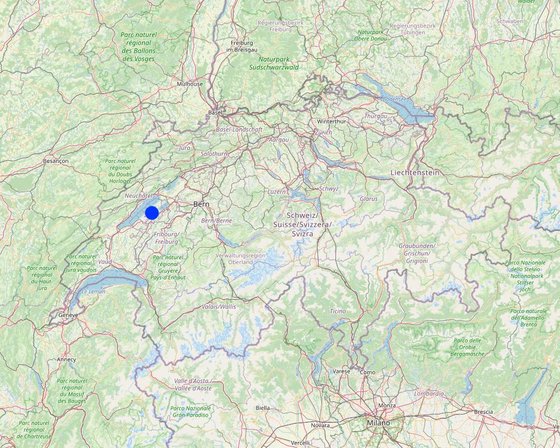
สถานที่: Missy / Vaud / Switzerland, สวิตเซอร์แลนด์
ตำนวนการวิเคราะห์เทคโนโลยี: พื้นที่เดี่ยว
ตำแหน่งทางภูมิศาสตร์ของสถานที่ที่ถูกเลือ
การเผยแพร่ของเทคโนโลยี: กระจายไปอย่างสม่ำเสมอในพื้นที่
In a permanently protected area?: ไม่ใช่
วันที่ในการดำเนินการ: 10-50 ปี
ประเภทของการแนะนำ
-
ด้วยการริเริ่มของผู้ใช้ที่ดินเอง
-
เป็นส่วนหนึ่งของระบบแบบดั้งเดิมที่ทำก้นอยู่ (> 50 ปี)
-
ในช่วงการทดลองหรือการทำวิจัย
-
ทางโครงการหรือจากภายนอก
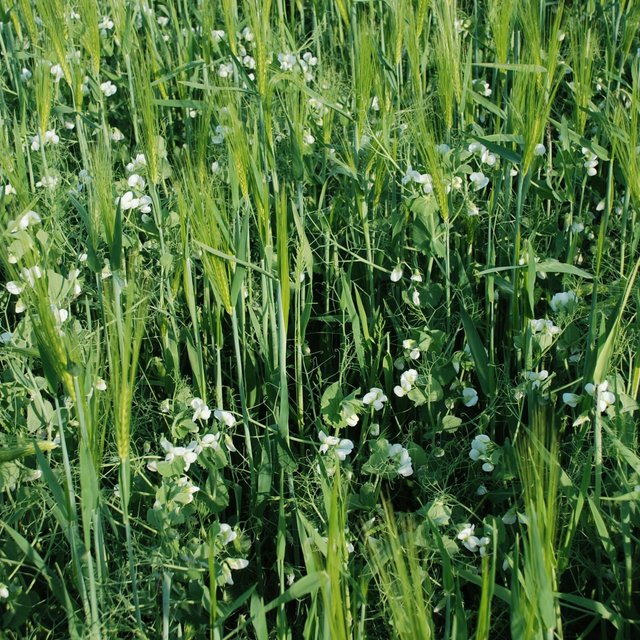
Intercropping of peas and barley in spring (Hansueli Dierauer (FiBL))
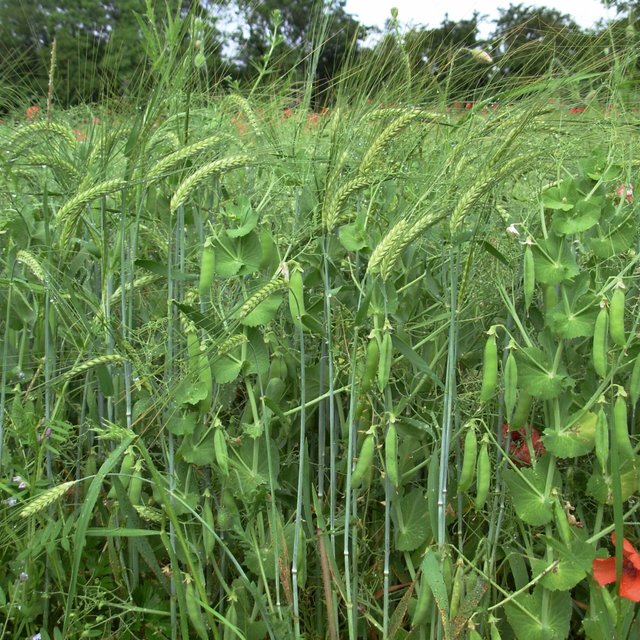
Mixed intercropping of pea and barley in summer (Cornelia Kupferschmid (FiBL))
จุดประสงค์หลัก
-
ปรับปรุงการผลิตให้ดีขึ้น
-
ลด ป้องกัน ฟื้นฟู การเสื่อมโทรมของที่ดิน
-
อนุรักษ์ระบบนิเวศน์
-
ป้องกันพื้นที่ลุ่มน้ำ/บริเวณท้ายน้ำ โดยร่วมกับเทคโนโลยีอื่นๆ
-
รักษาสภาพหรือปรับปรุงความหลากหลายทางชีวภาพ
-
ลดความเสี่ยงของภัยพิบัติ
-
ปรับตัวเข้ากับการเปลี่ยนแปลงภูมิอากาศของโลก สภาพภูมิอากาศที่รุนแรงและผลกระทบ
-
ชะลอการเปลี่ยนแปลงภูมิอากาศของโลกและผลกระทบ
-
สร้างผลกระทบทางด้านเศรษฐกิจที่เป็นประโยชน์
-
สร้างผลกระทบทางด้านสังคมที่เป็นประโยชน์
การใช้ที่ดิน
Land use mixed within the same land unit: ไม่ใช่
-
พื้นที่ปลูกพืช
- การปลูกพืชล้มลุกอายุปีเดียว: cereals - barley, cereals - oats, legumes and pulses - other, legumes and pulses - peas, Lupine (legume)
จำนวนของฤดูเพาะปลูกต่อปี: 1
Is intercropping practiced? ใช่
Is crop rotation practiced? ใช่
การใช้น้ำ
-
จากน้ำฝน
-
น้ำฝนร่วมกับการชลประทาน
-
การชลประทานแบบเต็มรูปแบบ
ความมุ่งหมายที่เกี่ยวข้องกับการเสื่อมโทรมของที่ดิน
-
ป้องกันความเสื่อมโทรมของที่ดิน
-
ลดความเสื่อมโทรมของดิน
-
ฟื้นฟูบำบัดที่ดินที่เสื่อมโทรมลงอย่างมาก
-
ปรับตัวกับสภาพความเสื่อมโทรมของที่ดิน
-
ไม่สามารถใช้ได้
ที่อยู่ของการเสื่อมโทรม
-
การกัดกร่อนของดินโดยน้ำ - Wt (Loss of topsoil): การสูญเสียดินชั้นบนหรือการกัดกร่อนที่ผิวดิน
กลุ่ม SLM
-
การปรับปรุงดิน / พืชคลุมดิน
-
การจัดการความอุดมสมบรูณ์ของดินแบบผสมผสาน
-
การปรับปรุงพันธุ์พืชหรือพันธุ์สัตว์ต่าง ๆ
มาตรการ SLM
-
มาตรการจัดการพืช - A1: พืช/สิ่งปกคลุมดิน, A2: อินทรียวัตถุในดิน/ความอุดมสมบูรณ์ในดิน, A5: การจัดการเมล็ดพันธุ์ การปรับปรุงพันธุ์
แบบแปลนทางเทคนิค
ข้อมูลจำเพาะด้านเทคนิค
The illustration shows a field where peas and barley are grown together in a mixed cropping system. The plants with rounded leaves and tendrils are peas, while the taller plants with linear leaves are barley. The interviewed farmer typically grows these crops on an area of two to three hectares. The mixed crops are at an advanced stage of growth, several weeks before harvest, with both pea and barley producing seed. The rooting depth of the pea plants can reach up to 110 centimetres, while the barley plants can extend their roots up to 150 centimetres under optimal conditions.
These plants grow on brown soil composed of three main horizons. Horizon A is usually brownish in colour and extends to a depth of over 20 cm. It is rich in organic matter and mineral particles, making it biologically active with many soil organisms and plant roots. The B horizon is lighter in colour and typically extends from about 20 cm to 150 cm deep. It contains minerals leached from the A horizon and shows signs of weathering, with a more defined structure due to the accumulation of minerals and organic matter from the upper layers. The C horizon, or parent material, lies below the B horizon and extends beyond 150 cm. It consists of partially disintegrated and weathered parent material, is typically lighter in colour than the B horizon and has minimal biological activity compared to the upper layers.
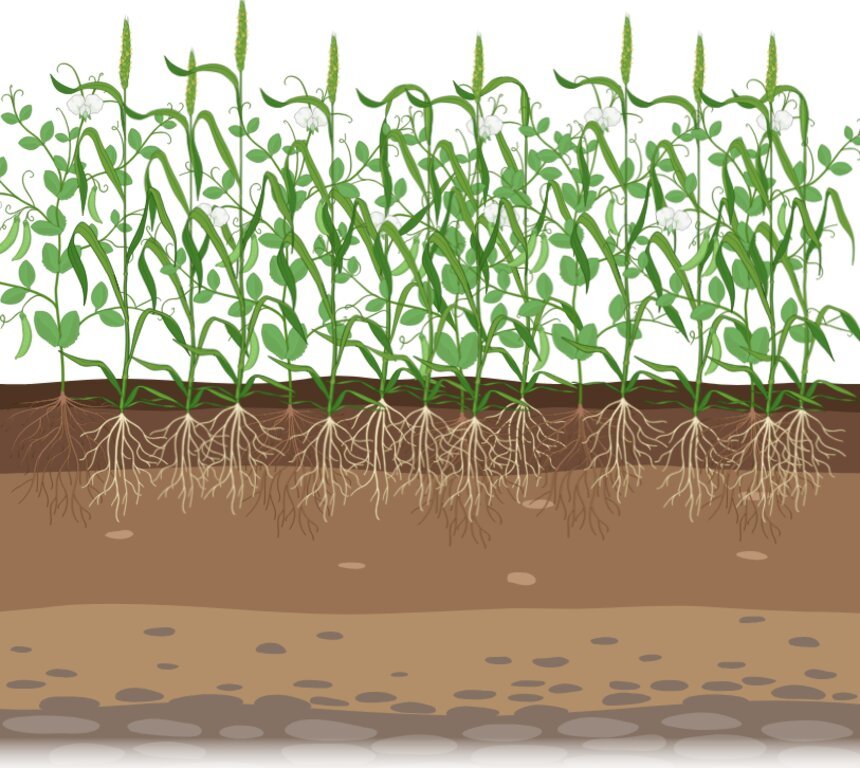
Author: Basile Brunner (UniBE)
llustration of benefits of intercropping for crop resilience and crop yields, management of soils, weeds, pests, and pathogens, along with environmental benefits of carbon sequestration and reduction of fossil fuel inputs.
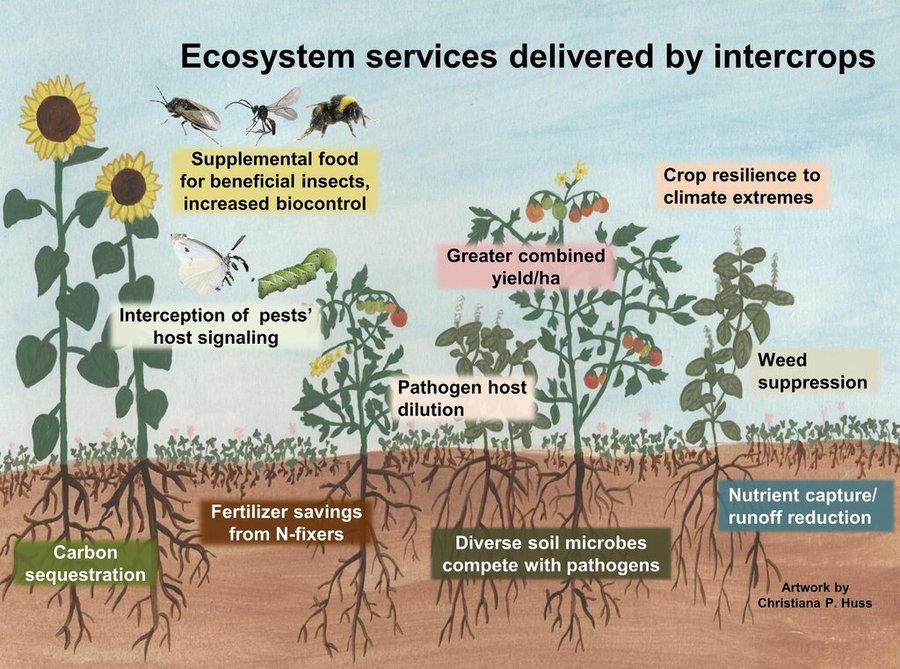
Author: Christiana Huss
การจัดตั้งและการบำรุงรักษา: กิจกรรม ปัจจัยและค่าใช้จ่าย
การคำนวนต้นทุนและค่าใช้จ่าย
- ค่าใช้จ่ายถูกคำนวน ต่อพื้นที่ที่ใช้เทคโนโลยี (หน่วยของขนาดและพื้นที่: ha)
- สกุลเงินที่ใช้คำนวณค่าใช้จ่าย CHF
- อัตราแลกเปลี่ยน (ไปเป็นดอลลาร์สหรัฐ) คือ 1 ดอลลาร์สหรัฐ = 1.13 CHF
- ค่าจ้างเฉลี่ยในการจ้างแรงงานต่อวันคือ 240 CHF
ปัจจัยที่สำคัญที่สุดที่มีผลต่อค่าใช้จ่าย
No exceptional investments are needed as existing machines are used.
The cost of seeds and the seed sorting costs by the mills.
Time and labour required for weeding, which can vary based on crop type.
The demand and price for the crops grown. E.g. soy having higher demand and price compared to peas.
กิจกรรมเพื่อการจัดตั้ง
n.a.
กิจกรรมสำหรับการบำรุงรักษา
-
Mixing seeds: For single tank seeders, mix seeds at a ratio of 80% peas and 40% barley. For multi-tank seeders, apply seeds of mixture partners separately. (ช่วงระยะเวลา/ความถี่: Before sowing, typically in late summer.)
-
Sowing: Use a row spacing of 12 cm, and place seeds at a depth of 3 to 4 cm. (ช่วงระยะเวลา/ความถี่: late october)
-
Assess the mix’s condition after winter. (ช่วงระยะเวลา/ความถี่: Spring, depending on winter severity.)
-
Weed Control: Generally not needed due to the competitive nature of the mixed crop. If high weed pressure: Consider harrowing once (2-3 hours per hectare for weeding). (ช่วงระยะเวลา/ความถี่: Spring, depending on winter severity.)
-
Harvesting: Adjust harvester sieves for peas. Open threshing concave and hulling bars wide. Maintain low drum rotation. Monitor for grain loss regularly. Adjust Vario-table to an aggressive cutting angle. (ช่วงระยะเวลา/ความถี่: Summer.)
ปัจจัยและค่าใช้จ่ายของการบำรุงรักษา (per ha)
| ปัจจัยนำเข้า |
หน่วย |
ปริมาณ |
ค่าใช้จ่ายต่อหน่วย (CHF) |
ค่าใช้จ่ายทั้งหมดต่อปัจจัยนำเข้า (CHF) |
%ของค่าใช้จ่ายที่ก่อให้เกิดขึ้นโดยผู้ใช้ที่ดิน |
|
แรงงาน
|
| Ploughing |
person-days |
1.0 |
200.0 |
200.0 |
100.0 |
| Sowing the Mixture |
person-days |
1.0 |
200.0 |
200.0 |
100.0 |
| Weeding |
person-hours |
3.0 |
23.0 |
69.0 |
100.0 |
|
อุปกรณ์
|
| seeder |
piece |
1.0 |
10000.0 |
10000.0 |
100.0 |
| tractor |
piece |
1.0 |
30000.0 |
30000.0 |
100.0 |
| harvester |
piece |
1.0 |
15000.0 |
15000.0 |
100.0 |
| plough |
piece |
1.0 |
15000.0 |
15000.0 |
100.0 |
|
วัสดุด้านพืช
|
| Seed mixture protein peas / barley mixture (autumn sowing) organic |
kg/ha |
200.0 |
6.0 |
1200.0 |
100.0 |
| ค่าใช้จ่ายทั้งหมดของการบำรุงรักษาสภาพเทคโนโลยี |
71'669.0 |
|
| Total costs for maintenance of the Technology in USD |
63'423.89 |
|
สิ่งแวดล้อมทางธรรมชาติ
ปริมาณน้ำฝนเฉลี่ยรายปี
-
< 250 ม.ม.
-
251-500 ม.ม.
-
501-750 ม.ม.
-
751-1,000 ม.ม.
-
1,001-1,500 ม.ม.
-
1,501-2,000 ม.ม.
-
2,001-3,000 ม.ม.
-
3,001-4,000 ม.ม.
-
> 4,000 ม.ม.
เขตภูมิอากาศเกษตร
-
ชื้น
-
กึ่งชุ่มชื้น
-
กึ่งแห้งแล้ง
-
แห้งแล้ง
ข้อมูลจำเพาะเรื่องภูมิอากาศ
ปริมาณเฉลี่ยฝนรายปีในหน่วยมม. 865.0
ชื่อสถานีอุตุนิยมวิทยา Payerne
average maximum temperature 14.2°C, average minimum temperature 5.1°C
ความชัน
-
ราบเรียบ (0-2%)
-
ลาดที่ไม่ชัน (3-5%)
-
ปานกลาง (6-10%)
-
เป็นลูกคลื่น (11-15%)
-
เป็นเนิน (16-30%)
-
ชัน (31-60%)
-
ชันมาก (>60%)
ภูมิลักษณ์
-
ที่ราบสูง/ที่ราบ
-
สันเขา
-
ไหล่เขา
-
ไหล่เนินเขา
-
ตีนเนิน
-
หุบเขา
ความสูง
-
0-100 เมตร
-
101-500 เมตร
-
501-1,000 เมตร
-
1,001-1,500 เมตร
-
1,501-2,000 เมตร
-
2,001-2,500 เมตร
-
2,501-3,000 เมตร
-
3,001-4,000 เมตร
-
> 4,000 เมตร
เทคโนโลยีถูกประยุกต์ใช้ใน
-
บริเวณสันเขา (convex situations)
-
บริเวณแอ่งบนที่ราบ (concave situations)
-
ไม่เกี่ยวข้อง
ความลึกของดิน
-
ตื้นมาก (0-20 ซ.ม.)
-
ตื้น (21-50 ซ.ม.)
-
ลึกปานกลาง (51-80 ซ.ม.)
-
ลึก (81-120 ซ.ม.)
-
ลึกมาก (>120 ซ.ม.)
เนื้อดิน (ดินชั้นบน)
-
หยาบ/เบา (ดินทราย)
-
ปานกลาง (ดินร่วน ทรายแป้ง)
-
ละเอียด/หนัก (ดินเหนียว)
เนื้อดิน (> 20 ซม. ต่ำกว่าพื้นผิว)
-
หยาบ/เบา (ดินทราย)
-
ปานกลาง (ดินร่วน ทรายแป้ง)
-
ละเอียด/หนัก (ดินเหนียว)
สารอินทรียวัตถุในดิน
-
สูง (>3%)
-
ปานกลาง (1-3%)
-
ต่ำ (<1%)
น้ำบาดาล
-
ที่ผิวดิน
-
<5 เมตร
-
5-50 เมตร
-
> 50 เมตร
ระดับน้ำบาดาลที่ผิวดิน
-
เกินพอ
-
ดี
-
ปานกลาง
-
ไม่ดีหรือไม่มีเลย
คุณภาพน้ำ (ยังไม่ได้รับการบำบัด)
-
เป็นน้ำเพื่อการดื่มที่ดี
-
เป็นน้ำเพื่อการดื่มที่ไม่ดี (จำเป็นต้องได้รับการบำบัด)
-
เป็นน้ำใช้เพื่อการเกษตรเท่านั้น (การชลประทาน)
-
ใช้ประโยชน์ไม่ได้
Water quality refers to: surface water
ความเค็มของน้ำเป็นปัญหาหรือไม่?
การเกิดน้ำท่วม
ความหลากหลายทางชนิดพันธุ์
ความหลากหลายของแหล่งที่อยู่
ลักษณะเฉพาะของผู้ใช้ที่ดินที่ประยุกต์ใช้เทคโนโลยี
เป้าหมายทางการตลาด
-
เพื่อการยังชีพ (หาเลี้ยงตนเอง)
-
mixed (subsistence/ commercial)
-
ทำการค้า/การตลาด
รายได้จากภายนอกฟาร์ม
-
< 10% ของรายได้ทั้งหมด
-
10-50% ของรายได้ทั้งหมด
-
> 50% ของรายได้ทั้งหมด
ระดับของความมั่งคั่งโดยเปรียบเทียบ
-
ยากจนมาก
-
จน
-
พอมีพอกิน
-
รวย
-
รวยมาก
ระดับของการใช้เครื่องจักรกล
-
งานที่ใช้แรงกาย
-
การใช้กำลังจากสัตว์
-
การใช้เครื่องจักรหรือเครื่องยนต์
อยู่กับที่หรือเร่ร่อน
-
อยู่กับที่
-
กึ่งเร่ร่อน
-
เร่ร่อน
เป็นรายบุคคลหรือกลุ่ม
-
เป็นรายบุคคล/ครัวเรือน
-
กลุ่ม/ชุมชน
-
สหกรณ์
-
ลูกจ้าง (บริษัท รัฐบาล)
อายุ
-
เด็ก
-
ผู้เยาว์
-
วัยกลางคน
-
ผู้สูงอายุ
พื้นที่ที่ใช้ต่อครัวเรือน
-
< 0.5 เฮกตาร์
-
0.5-1 เฮกตาร์
-
1-2 เฮกตาร์
-
2-5 เฮกตาร์
-
5-15 เฮกตาร์
-
15-50 เฮกตาร์
-
50-100 เฮกตาร์
-
100-500 เฮกตาร์
-
500-1,000 เฮกตาร์
-
1,000-10,000 เฮกตาร์
-
>10,000 เฮกตาร์
ขนาด
-
ขนาดเล็ก
-
ขนาดกลาง
-
ขนาดใหญ่
กรรมสิทธิ์ในที่ดิน
-
รัฐ
-
บริษัท
-
เป็นแบบชุมชนหรือหมู่บ้าน
-
กลุ่ม
-
รายบุคคล ไม่ได้รับสิทธิครอบครอง
-
รายบุคคล ได้รับสิทธิครอบครอง
สิทธิในการใช้ที่ดิน
-
เข้าถึงได้แบบเปิด (ไม่ได้จัดระเบียบ)
-
เกี่ยวกับชุมชน (ถูกจัดระเบียบ)
-
เช่า
-
รายบุคคล
สิทธิในการใช้น้ำ
-
เข้าถึงได้แบบเปิด (ไม่ได้จัดระเบียบ)
-
เกี่ยวกับชุมชน (ถูกจัดระเบียบ)
-
เช่า
-
รายบุคคล
เข้าถึงการบริการและโครงสร้างพื้นฐาน
ความช่วยเหลือทางด้านเทคนิค
การจ้างงาน (เช่น ภายนอกฟาร์ม)
ผลกระทบ
ผลกระทบทางด้านเศรษฐกิจและสังคม
การผลิตพืชผล
Higher land use ratio (more biomass per hectare).
คุณภาพพืชผล
Cereals in the mixture prevent weeds from spreading within the legumes. But cereals (e.g. barley) of a lower quality than if they were grown in a monoculture.
การเสี่ยงต่อความล้มเหลวในการผลิต
If legumes are not growing well, fertiliser can be added and cereals can be harvested.
ความหลากหลายของผลิตภัณฑ์
The same products are harvested as in a monoculture, but at the same time.
พื้นที่สำหรับการผลิต (ที่ดินใหม่ที่อยู่ในระหว่างเพาะปลูกหรือใช้งาน)
การจัดการที่ดิน
Less intervention (e.g. weeding, fertilisation) required.
ความต้องการน้ำจากการชลประทาน
Water demand remains approximately the same as in monoculture.
ค่าใช่จ่ายของปัจจัยการผลิตทางการเกษตร
Reduced expenditure on organic crop protection & weeding thanks to cereals' positive effect on weed control (compared to legume monoculture).
รายได้จากฟาร์ม
As mixed cropping can be used within the crop rotation, it only leads to a slight increase in the farmer's income.
ความหลากหลายของแหล่งผลิตรายได้
The same crops are cultivated as in monoculture.
ภาระงาน
Less intervention (e.g. weeding) required as cereals protect legumes from weeds and legumes provide nitrogen to cereals.
ผลกระทบด้านสังคมและวัฒนธรรม
ผลกระทบด้านนิเวศวิทยา
การระเหย
Good soil cover due to mixed cultivation slightly reduces evaporation.
การหมุนเวียนและการเติมของธาตุอาหาร
Legumes fix nitrogen in the soil.
การปกคลุมด้วยพืช
Slightly higher due to mixed species.
มวลชีวภาพ/เหนือดินชั้น C
slightly higher because of species mixture
ความหลากหลายทางชีวภาพของพืช
Slightly higher due to mixed species.
พืชพันธุ์ต่างถิ่นที่รุกล้ำเข้ามา
Slightly less due to weed suppression in cereals.
ชนิดพันธุ์ที่ให้ประโยชน์ (ผู้ล่า ไส้เดือนดิน แมลงผสมเกสร)
Legumes provide flowers for pollinators.
ผลกระทบนอกพื้นที่ดำเนินการ
รายได้และค่าใช้จ่าย
ผลประโยชน์ที่ได้รับเปรียบเทียบกับค่าใช้จ่าย
ผลตอบแทนระยะสั้น
ด้านลบอย่างมาก
ด้านบวกอย่างมาก
ผลตอบแทนระยะยาว
ด้านลบอย่างมาก
ด้านบวกอย่างมาก
ผลประโยชน์ที่ได้รับเปรียบเทียบกับค่าใช้จ่ายในการบำรุงรักษา
ผลตอบแทนระยะสั้น
ด้านลบอย่างมาก
ด้านบวกอย่างมาก
ผลตอบแทนระยะยาว
ด้านลบอย่างมาก
ด้านบวกอย่างมาก
การเปลี่ยนแปลงของสภาพภูมิอากาศ
การเปลี่ยนแปลงสภาพภูมิอากาศที่ค่อยเป็นค่อยไป
อุณหภูมิตามฤดูกาล เพิ่มขึ้น
อุณหภูมิตามฤดูกาล เพิ่มขึ้น
อุณหภูมิตามฤดูกาล เพิ่มขึ้น
อุณหภูมิตามฤดูกาล เพิ่มขึ้น
สภาพรุนแรงของภูมิอากาศ (ภัยพิบัติ)
พายุฝนฟ้าคะนองประจำท้องถิ่น
การน้อมเอาความรู้และการปรับใช้
เปอร์เซ็นต์ของผู้ใช้ที่ดินในพื้นที่ที่นำเทคโนโลยีไปใช้
-
ครั้งเดียวหรือเป็นการทดลอง
-
1-10%
-
11-50%
-
> 50%
จากทั้งหมดที่ได้รับเทคโนโลยีเข้ามามีจำนวนเท่าใดที่ทำแบบทันที โดยไม่ได้รับการจูงใจด้านวัสดุหรือการเงินใดๆ?
-
0-10%
-
11-50%
-
51-90%
-
91-100%
เทคโนโลยีได้รับการปรับเปลี่ยนเร็วๆ นี้เพื่อให้ปรับตัวเข้ากับสภาพที่กำลังเปลี่ยนแปลงหรือไม่?
สภาพที่กำลังเปลี่ยนแปลงอันไหน?
-
การเปลี่ยนแปลงแบบค่อยเป็นค่อยไปและสภาพรุนแรงของภูมิอากาศ
-
การเปลี่ยนแปลงของตลาด
-
การมีแรงงานไว้ให้ใช้ (เนื่องจากการอพยพย้ายถิ่นฐาน)
Decrease for market reasons (barley has low market price) & more adapted varieties (pea varieties that are more resistant to wind damage).
บทสรุปหรือบทเรียนที่ได้รับ
จุดแข็ง: มุมมองของผู้ใช้ที่ดิน
-
Mixed cropping works very well, providing both legume and cereal yields.
-
Certain crops, like oats, help suppress weeds, reducing the need for additional weeding. Thus saving costs (PPPs & labour) and reducing workload (hours of weeding).
-
Legumes contribute to nitrogen fixation, improving soil fertility for subsequent crops.
-
Mixed cropping reduces the risk of total crop failure, as one crop can compensate if the other underperforms.
จุดแข็ง: ทัศนคติของผู้รวบรวมหรือวิทยากรคนอื่นๆ
-
If one crop fails, the other can still provide a harvest, ensuring some yield.
-
Mixed cropping can produce more biomass on the same land compared to monocultures.
-
It enhances soil diversity, supports pollinators, and contributes to nitrogen enrichment.
-
Good market price for protein peas. Additionally, the farmer receives a subsidy for grain legumes (including protein peas), if the harvest contains at least 30% grain legume seeds. In addition, the cantons of Jura and Vaud pay cantonal contributions to farmers who cultivate mixed crops. The farmers can also get extra payments by the organic farmer organisation Bio Suisse if certain grain legume species of high demand are cultivated (see Agridea Deckungsbeitrag catalogue for more information).
จุดด้อย/ข้อเสีย/ความเสี่ยง: มุมมองของผู้ใช้ที่ดินแก้ไขปัญหาได้อย่างไร
-
Legumes are not growing well due to a cold winter.
Adding fertilizer can help growing the cereal and enables the farmer to still harvest something.
-
Water competition in a dry summer results in a bad crop quality.
Ensure efficient irrigation to reduce competition for water between mixed crops.
-
Barley has a very low market value.
Choose crop varieties that are better adapted to market demands.
จุดด้อย/ข้อเสีย/ความเสี่ยง: ทัศนคติของผู้รวบรวมหรือวิทยากรคนอื่นๆแก้ไขปัญหาได้อย่างไร
-
During drought stress, competition for water between the two crops can occur, leading to potential yield losses or low quality yield.
Use drought-tolerant varieties or species with deep roots for mixed cropping. This can help reduce competition for water and improve resilience during dry periods.
-
Limited market demand for certain crops like barley.
Focus on crops with higher market demand.
-
Need for minimal fertilization in mixed cropping can reduce yield quality of cereals like barley.
Implement targeted fertilization strategies to balance the needs of both crops.
การอ้างอิง
Editors
-
Maria Eliza Turek
-
Tatenda Lemann
-
Joana Eichenberger
ผู้ตรวจสอบ
-
William Critchley
-
Joana Eichenberger
วันที่จัดทำเอกสาร: 22 เมษายน 2022
การอัพเดทล่าสุด: 10 กันยายน 2024
วิทยากร
-
Lucien Quillet - ผู้ใช้ที่ดิน
-
Matthias Klaiss - ผู้เชี่ยวชาญ SLM
คำอธิบายฉบับเต็มในฐานข้อมูล WOCAT
การจัดทำเอกสารถูกทำโดย
องค์กร
- CDE Centre for Development and Environment (CDE Centre for Development and Environment) - สวิตเซอร์แลนด์
โครงการ
- OPtimal strategies to retAIN and re-use water and nutrients in small agricultural catchments across different soil-climatic regions in Europe (OPTAIN)
การอ้งอิงหลัก
-
Huss, C. P., Holmes, K. D., & Blubaugh, C. K. (2022). Benefits and risks of intercropping for crop resilience and pest management. Journal of Economic Entomology, 115(5), 1350–1362. https://doi.org/10.1093/jee/toac045:
-
Klaiss, M. (2021). Intercropping of grain pea with cereals (Legumes Translated Practice Note 17, S. 1–4). Institute of Organic Agriculture FiBL. https://orgprints.org/id/eprint/42384/:
-
Alföldi, T., Haug, B., Messmer, M., Goldringer, I., Forst, E., Mary-Huard, T., Enjalbert, J., & Hohmann, P. (2020). Mischkulturen Erbsen/Gerste - Braucht es eine eigene Züchtung? EU-Projekt ReMIX (Video). Forschungsinstitut für biologischen Landbau FiBL, CH-Frick. Retrieved 31 July, 2024, from https://orgprints.org/id/eprint/37276/:
-
Haug, B., Messmer, M., Enjalbert, J., Goldringer, I., Flutre, T., Mary-Huard, T., & Hoh-mann, P. (2023). New insights towards breeding for mixed cropping of spring pea and bar-ley to increase yield and yield stability. Field Crops Research, 297, 108923. https://doi.org/10.1016/j.fcr.2023.108923:
-
Hiltbrunner J., Wüst S., Blatter A., Vonzun S., Klaiss M., Messmer M. (2023). Optimierung des Mischkultursystems Erbse-Gerste zur Sicherung der lokalen Eiweissversorgung. Feld-rundgänge & Präsentation Projekt PROMISE 2023. Agroscope. Stiegenhof, Arenenberg, Utzenstorf & Sargans. https://ira.agroscope.ch/de-CH/publication/53643:
-
Vonzun S., Blatter A., Wüst S., Hiltbrunner J., Schneider M., Messmer M. (2023). Investi-gating mixed cropping systems with pea and lentils for climate-smart and demand oriented agriculture. Fourth International Legume Society Conference 2023. 19 September, Granada. https://ira.agroscope.ch/de-CH/publication/55455:
ลิงก์ข้อมูลที่เกี่ยวข้องที่มีอยู่ในออนไลน์











